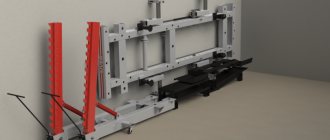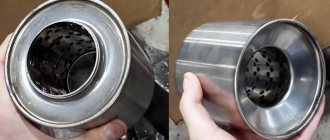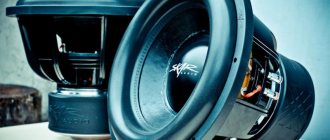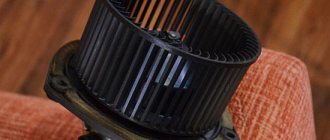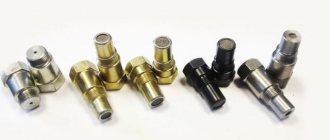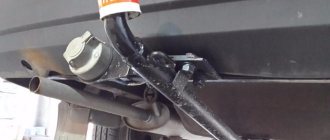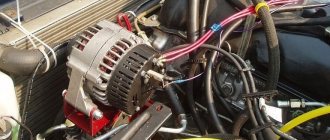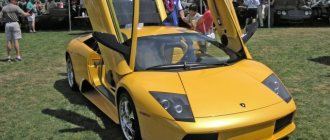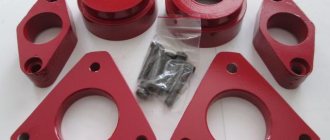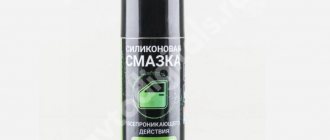Situations in life are different. As traffic on the roads increases, the risk of becoming a victim of both your own carelessness and other drivers on the roads of our state increases proportionally.
Considering the state of transport lines, the likelihood of such an outcome in 2022 is extremely high even for a diligent motorist. With large dents, you cannot do without major repairs, but if the car has a couple of concavities, you can really solve the problem at home.
It is enough to make a slipway with your own hands, and the number of calls to auto repair shops will be significantly reduced. In today's article we will analyze the design of the garage device + provide instructions for its assembly.
Types of slipways and their main differences
There are 4 types of design:
- Floor-standing. Standard rail mounted design.
- Roll-on. Small in size. Such structures are stored in a garage or workshop.
- Frame. Structures on chains designed for complete repairs and lifting the machine to a height.
- Platform. Designed for professional repairs. Suitable for large machines.
Floor structures
The floor slipway is also called stationary. Its difference is that there are rails on the floor that allow you to move the mechanisms. With their help it is easy to carry out body work.
The stationary slipway is convenient thanks to retractable mechanisms.
Floor structures have 3 advantages:
- They take up little space.
- They cost less than other slipways.
- Fast installation of transport.
The disadvantage is the complexity of installation of the structure.
Roll-up
A rolling slipway is a slipway that is used for light repair work if there is no full-fledged slipway or its use is impossible for some reason. The difference is that the rolling slipway is small in size - it is not necessary to roll the car up to it. You can bring the rolling slipway to the car.
This design has advantages:
- It is customizable for different types of cars.
- Possibility of equipping the device with hydraulics.
- The clamp fastening design has no analogues.
- Can be used with most types of machines.
- Compact size.
The disadvantage is that it is impossible to carry out complex work involving large distortions.
Frame
A distinctive feature of frame structures is the use of the frame as a base. The car is secured with chains. Most often this design is used for minor repairs. But, at the same time, the structure of frame stocks is more complex than others. They are equipped with grippers that allow you to fix the car body in the required position or even lift it to a certain height.
Platform models
The platform model is very similar to the trestle structure. It allows you to pull the car body in any direction. A lot of different equipment can be installed on the slipway platform. Pulling on a platform is very convenient, and the functionality is enough to make professional repairs right in the garage.
How the equipment works
The operating principle is the same for all devices. To restore the geometry of the body, it is fixed to any one or several sections of the slipway. Then the car mechanic, using a traction device and applying force using hydraulic devices, pulls out the deformed elements. If you make a slipway in the garage with your own hands, then it is, as a rule, a simple system that has one exhaust mechanism. There are several of them in factory equipment.
Tools and materials for creating a structure
We will need the following materials and tools:
- Metal profiles.
- Extended profiles (needed for racks).
- Metal corners.
- Welding machine.
- Bolts and nuts.
- Fastening mechanisms.
- Paint and primer.
- Chains and hooks.
- Hydraulic equipment.
- Spray gun.
- Power rack.
Exterior modernization
The Niva SUV is one of those cars that are not afraid of experiments. The model is “omnivorous” in terms of body tuning and readily accepts all popular innovations. Of primary importance in this direction are protective equipment, among which is crankcase protection. This component will prevent damage to the power unit and other components located close to the bottom of the car. Also, external tuning of the VAZ-2121 provides for the installation of reinforced thresholds. This addition will not only be a good assistant in operations with the jack, but will also make the operation of the machine more convenient in general. The aerodynamic characteristics of the SUV are improved thanks to a special body kit, grilles, spoiler and air intakes. Finally, connoisseurs of aesthetics can recommend body airbrushing, which will emphasize the brutal character of the updated Niva.
Step-by-step construction instructions
The construction of any home-made structures begins with the design stage. You need to make a slipway that is convenient to use. It is important that it does not take up too much space, blocking free movement.
The second point is always the creation of the structure's frame. The last point is to install fasteners and tightening devices yourself.
Drawings and dimensions
First you need to make suitable drawings. Ready-made options can be found below. The markings are made according to the dimensions of the vehicle. Afterwards the stage of preparation and selection of tools and materials begins. We will also need to make a mounting system large enough to fit our vehicle. It would be nice to cook it with the ability to change the height.
- Once all the drawings are ready and the materials have been selected, you can start working. First you will have to remove moisture from the materials and coat them with a primer. You can paint them right away, or you can leave this step for last.
- Now weld the metal corners to the base profile.
- Weld the profile (this will be the stand). It is secured with bolts.
- Now the chains, hooks and retractable devices are welded.
Frame making
The frame is responsible for fixing the car. Therefore, you need to be careful when creating it.
- Before creating the frame, you need to create the outer frame. It is to this that the frame will be mounted.
- A metal profile is suitable as a material. A stand and grips are attached to it (they are needed to fix the car threshold).
- Now the thresholds are being made. They are created from metal corners.
- Thresholds are installed on beams and secured with bolts.
- After installation, all elements will have to be secured by welding.
Fastening the body to the slipway
Clamps are required for fastening. If you can't buy them, make your own. You will need railway platforms (what the rails are attached to the sleepers). Each of the platforms is cut in half, and metal is welded onto the inside. It is cut into diamonds using a grinder.
You don't need to do anything to the outside. A plate 4 millimeters thick is also welded to the inside. It is important that the clamping device fixes the threshold and does not bend during use.
Installation of rack and pulling devices
Factory hydraulic attachments are suitable for racks and devices. If they cannot be purchased, a homemade mechanism will do. The power of the device should be from 1 to 2 tons. To attach the pulling devices, you need a pad. It is made from a channel and installed in the frame of the slipway. To place the tightening mechanism and chains in any place, it is necessary to make holes in the frame along the entire slipway.
If the stand is made independently, it is recommended to use a tower device. It is heavy, but the restoration of the car will be uniform.
Making a slipway is not that difficult. If you have basic knowledge of construction, you can easily do everything yourself. The main thing is to choose the right material and make the right drawings.
The importance of controlling and maintaining body geometry
So much has been said about the fact that the stocks are capable of restoring body geometry. At the same time, not everyone fully understands why this is done and why the machine cannot be operated with any deviations relative to its factory geometry.
Body geometry or body geometry refers to the exact dimensions of a vehicle, specified at the production stage. Key parameters include:
- front track width,
- rear track width,
- wheelbase length,
- length of the side members,
- distance between side members.
The body consists of a large number of parts that form a supporting system. During normal use, parts begin to shift slightly. This is due to the less than ideal condition of the road surface, vibrations, collisions with bumps and holes, sudden forced braking, etc. A process of natural wear and tear occurs, which can be characterized as metal fatigue.
But under normal conditions this process proceeds very slowly. But there are situations when the shift occurs suddenly and sharply. This is possible in case of an accident, serious mechanical damage, when the car falls into a large hole at high speed, or in collisions with obstacles. As a result, the geometry is violated, that is, the car no longer meets its factory standards.
In such situations, high-quality restoration of the modified geometry of the car body helps. It can be restored on the slipway. This type of repair allows you to restore the car after accidents and continue normal operation.
If you ignore the need for repairs, this may manifest itself in the form of the following problems:
- doors don't close well,
- The hood and trunk do not close tightly,
- the car behaves unstably at high speed,
- the car skids even though the steering wheel is straight,
- the car stops obeying the driver,
- vibration appears
- the metal gradually deteriorates,
- the load increases,
- body elements and associated components wear out,
- fastenings are destroyed.
How dangerous all this is, each of you can guess for yourself.
Therefore, it is important to check the geometry not only in the event of an accident and various types of severe damage, but also after a fairly long service life of the car
Some car owners, in order to prevent and prevent the development of problems, carry out diagnostics of the condition of the body at least once every 2 years. This is especially true for those who are forced to travel on bad roads, which contribute to rapid wear of body elements and accelerate metal fatigue.
Body stocks are objectively sometimes irreplaceable equipment in matters of vehicle repair. They help in restoration and extend the life of the car.
To what extent such an installation is needed at home is an extremely controversial issue. But every auto repair shop that provides body repair services is simply obliged to have a professional and high-quality slipway at its disposal.
Why do you need to maintain the basic geometry of the body base?
Quite often there are situations when car drivers turn to car service centers in order to correct deformations of the base of the body of various types and types of complexity that appeared after:
- hitting various obstacles;
- collisions with other cars;
- after the car overturned.
Distortion of the basic geometry of the body can be identified by taking measurements of the body at the main control points of the body geometry, the exact coordinates of which are indicated in the specially attached documentation on the technical characteristics of the car. After taking measurements, it is determined that the values do not correspond to the normal values specified in the documents, and the conclusion is that the body is skewed and requires straightening.
Car body restoration
In order to correct the resulting deformations of the body, it is necessary to apply a specifically directed force to the metal itself. It is for these purposes that the slipway is equipped with special hydraulic drives, as well as various devices for securing one part of the body and additionally securing the remaining parts. Concluding from the fact that each car is deformed to varying degrees, it is worth considering each type of deformation as unique in its own way, requiring body repairs of varying levels of complexity. It is for these purposes that there are quite a large number of varieties of slipway devices that can help carry out repair work, as well as correcting body defects with different levels of complexity.
Manufacturing of a straightening stand
The exact dimensions of the slipway depend on the type of vehicle being serviced. A profile of 4.5 m in length for such a design will be sufficient, and a width of 2 m will ensure convenient installation of the machine. To make the frame, a channel with a cross section of 50-120 mm is suitable, which forms a solid platform for installing the machine. Considering that the load from the power tower on the profile will try to rotate it, it is necessary to install powerful stiffeners. The frame is assembled using welding tacks, and after adjustment, final welding is performed. In general, all actions have the following order:
- Assembling the structure according to the developed scheme;
- Welding the body of the slipway taking into account all the stiffeners;
- Assembly and installation of fasteners for fixing the car;
- Installation of power rack and additional equipment;
- Installation of chains, grips and brackets.
When performing such work, special attention must be paid to the rigidity of the structure. It is possible to organize repairs on the slipway only if the machine is securely fastened
You should be careful about safety issues. Loads acting on the vehicle frame during stretching can not only damage the car, but also cause a significant impact on health.
Spotter
The spotter is used for body repair and helps, like a reverse hammer, to tap small deformed parts. This is one of the methods of machine straightening, which is performed point by point using similar equipment. In this regard, this miniature device has many advantages over a conventional device:
- The straightening work is carried out efficiently.
- The working time with the spotter is short.
- There is no need to disassemble the car to perform auto repairs.
- The unique operating principle allows the spotter to eliminate mechanical damage and defects of the body, including the hood, fenders, and sills.
Straightening with a spotter will allow a car owner who wants to repair the car themselves to save on costs. To choose the right spotter, you should take into account the nature of the damage to the car.
Platform devices
Such devices are usually used for complex repairs. This is a metal platform with a reliable system of clamps and fastenings located on it. Such slipways may have several power towers. They often have a scissor lift attached to them.
It is especially valuable that the deformed fragment on them can be pulled in all directions. In addition, a reliable fastening system expands the range of repair work.
Results
As you can see, the hybrid brush is indeed a rather interesting and promising product. These wipers have many advantages, are versatile and have a high level of performance. The price is higher than the cost of frame and frameless solutions, but it is fully justified by manufacturability and a lot of advantages.
Carrying out preparatory work
Before making a slipway, it will be necessary to carry out a number of preparatory work. So, it is worth determining in advance what kind of work will be performed on it, and what car models can be repaired with its help. For example, if you decide to open a body shop, then you will need a platform device, but for small household work, a frame unit is quite suitable.
Having decided on the type of slipway, you should prepare the floor of the room where it will be installed. Thus, the frame structure will require deepening of the fasteners for it into the floor, as well as securing them with cement mortar. But the platform can be completely installed in the garage without attaching it to the floor, since its weight will allow the necessary body work to be carried out.
Tags: body clamp, slipway, do it yourself
Comments 66
Hello. There's no need to waste time here. It’s better to make your own adaptations for the slipway and spotter, etc. Good factory metal lasts for many years. The file won't take it. But if the clamps are g... Then you can even throw the factory in the trash. They are of little use. They bend, the notch is eaten instantly. There are also quality Chinese ones. Now everything is Chinese. You need to look when you take it.
Yes, I later bought a factory one, it coped with its task)
Everyone here advises you to buy it because... metal G, out of idle curiosity I want to ask if it is possible to find high-quality metal or at an expensive price.
you can find it, you’ll just have to mill it from a solid one
Adaptation for a torture chamber?
yeah for a dentist
it would be funnier - for a urologist
The factory clamp solves the problem, this homemade product is complete bullshit, it won’t fit anywhere with scarves later. I use inexpensive tota clamp clamps, maybe you can find them in your region. I use chains from a coal conveyor. I cut one link as a connector, so far I haven’t been able to straighten it, although there are and minibuses and cargo cabins, and there’s a lot of metal there.
IMHO: the wedge should be made sharper...thereby the clamping force will be greater...well, the long sides of the “jaws” could be thicker...
only if you weld the front walls or weld the back mortgages
buy the real ones at the store... you'll suffer with the homemade gun... yes... they're expensive... but they work as expected...
It is advisable to change the operating principle of the clamp. A simple grab breaks the winch with a force of 250 kg. It is necessary with a wedge clamp, the harder you pull, the more the gripping jaws compress.
This one is much weaker than mine, it’s definitely for me to pull out the spar and not a jammed empty seam. rather weak
Mine is tested and pulls 2.5 tons, but yours is drawn and not tested. There is no justification for the assumption of weakness...
what does 2.5 tons mean and how is force measured?
winch 2.5 tons. which he pulled to the limit and tapped with a reverse hammer to relieve the tension... You are too self-confident.
It’s not a matter of self-confidence, the rigidity of the structure is simply not visible, all hope is in the thickness of the metal
It seems to me that the quality of the metal will not allow the idea to be realized. will bend. and if you cook it, it will weaken it even more. dangerous if it breaks
Idk. If it’s filthy ferrous metal, then at least cook it. trying is not torture. If it flies off once, we'll see. I'd rather buy a normal clamp
You can’t heat it, it will tear when jerking...
It seems to me that the quality of the metal will not allow the idea to be realized. will bend. and if you cook it, it will weaken it even more. dangerous if it breaks
What difference does it make what you cook?
The heating area is, firstly, smaller and the properties of the metal are completely different from those of the arc.)
yeah, and if it doesn’t warm up, it won’t cook
The heating area is, firstly, smaller and the properties of the metal are completely different from those of the arc.)
in this case, under such loads, welding is not very reliable. maybe I'm wrong. but taking risks is more expensive for yourself
The heating area is, firstly, smaller and the properties of the metal are completely different from those of the arc.)
not long ago I cooked a “miracle shovel” from 12 rods and a profile. I’ve already tried to pin and strengthen it. I cooked it semi-automatically - one horseradish bends and breaks. I never expected this. and all our construction ferrous metal is like this.
It seems to me that the quality of the metal will not allow the idea to be realized. will bend. and if you cook it, it will weaken it even more. dangerous if it breaks
Sanding is the final stage of restoration
After the homemade tools and accessories for body restoration have completed the task, you should proceed to sanding the repaired surface. The following equipment can be used for these purposes:
- Grinding machine with a set of discs of different grain sizes.
- Electric drill with abrasive attachments.
- Sandpaper secured to a block.
Timely elimination of body defects will allow you to quickly restore the vehicle's performance characteristics, improve its appearance and prevent further destruction of the body due to corrosion, which forms primarily in damaged areas. Monitor the condition of your car and do not put off repairing it until later, as this may lead to the need for more complex and expensive body repairs.
In the distant fifties and sixties of the last century, the arsenal for straightening a car body looked very impressive and consisted of dozens of items. Virtuoso craftsmen could almost “one-on-one” restore any twisted piece of iron. Leaving almost no dents.
Moreover, popular rumor claims that during a time of total shortage of body parts (and not only them), there were artisans who supposedly could make a new body part such as the front wing for the twenty-first Volga manually from sheet iron. This life suited everyone. Time then flowed slowly, and no one counted it.
That's the case now! The pace of life has increased to such an extent that time has become an absolute value. This inevitably led to the fact that, as already mentioned, replacement of the damaged part was preferred to straightening. However, straightening has not gone away and will not go anywhere in the near future. The volume of straightening in the total volume of repair work has simply decreased. Therefore, the arsenal of tools used for straightening looks much more modest than in those distant times.
Straightening hammers and supports.
Straightening hammers and supports are used for straightening (straightening) metal. Supports, or anvils, come in different shapes and sizes. Their working surface also varies. Either smooth, almost polished, or notched. The photo below shows a set of straightening hammers and anvils made in China.
All parts are cast from cast iron. Compared to the kit of a professional straightener, which contains dozens of items, it looks quite modest. But, in my opinion, this set will be quite enough for you, unless, of course, you want to become a virtuoso straightener.
Straightening hammer with a striker made of non-ferrous metal (copper or aluminum).
Used for finishing straightening of metal. A copper or aluminum hammer practically does not stretch or crush the metal being straightened.
Reverse or inertial hammer for straightening and straightening dents on body metal.
It is used for straightening and when correcting dents on body metal in situations where access to the inner surface of the damaged panel is difficult or completely absent. In this case, the metal is pulled out using a reverse or inertial hammer.
Machine on platform
Distinguished by its high reliability and powerful fastening system, the platform slipway is good because it can easily pull the car body in all directions. In addition, it can perform other types of operations, such as finishing dents and minor damage. The platform slipway also allows you to adjust the geometry of the body and frame.
The good thing about a platform slipway is that to install equipment on it you do not need an initially prepared base, because the machine is already equipped with everything necessary, including the platform on which the machine is placed.
Let's look at the most popular types of platform slipways, their prices and features in the table below.
| Model | Cost, rubles | Technical data | Equipment | Peculiarities |
| Platform slipway NORDBERG BAS12 | 682 000 | Platform length 5190 mm; platform width 2120 mm; working platform height 570 mm; pressure in the hydraulic system 70 MPa; maximum turret thrust force 95 KN (KH); force application angle 360°; maximum liftable weight 3000 kg | A measuring ruler, a crane for straightening roofs, two carts for rolling up a car, a hand winch. | When designing the NORDBERG BAS12 stand for editing body geometry, advanced technologies were used and all the advantages and disadvantages of the most famous brands of stocks were taken into account. Strength, precision, flexibility, lightness, practicality and safety - these are the principles of Nordberg stands. |
| Platform slipway FA-2 | 696 000 | Platform length 5190 mm; platform width 2120 mm; platform height 570 mm; column force 10,000 kg; maximum lifting weight 3000 kg; gross weight 2300 kg | Lifting platform; 2 power towers; yardstick; 2 pneumohydraulic pumps; drive-in ramps; 4 standard clamps; mobile stand with equipment | Platform slipway for restoring the geometry of car bodies with damage of any complexity. The platform of the slipway has longitudinal grooves, which allows you to install 4 body grips anywhere on the platform. |
| Platform slipway ATIS B05 | 769 000 | Platform length 5200 mm; platform width 2100 mm; working platform height 500 mm; pressure in the hydraulic system 70 MPa; maximum traction force of the tower is 100 KN; cross-sectional diameter of the power tower is 160 mm; force application angle 360 degrees; maximum lifting weight 3500 kg; total weight of equipment is 2200 kg. | Platform (5200*2100mm) Base with lifting mechanism Power tower with hydraulic cylinder with safety anti-fall system Power tower with hydraulic cylinder Universal clamps Base for universal clamps Pneumo-hydraulic pump Stand for mounting wheels Rolling trolleys Manual winch Access ramps Shield for accessories and fixtures Set grips and clamps 16 items Measuring telescopic ruler with magnetic self-centering lock | The ATIS B05 slipway incorporates the most advanced technologies in the world. All problems that exist when restoring the geometry of the body were also taken into account. This equipment is aimed at practicality, safety and accuracy. The concept of design, professional approach to production and technology, makes Doocar slipways distinguished by their quality. |
Conclusion
One of the main features of the slipway is the preservation of the geometry of the body. Why is this necessary? Primarily due to a significant displacement of the front or rear track, wheelbase, etc. A sudden breakdown may occur, which, in turn, leads to dangerous consequences. During long-term operation of any car, a slight displacement still occurs, but this cannot be compared with changes in the geometry of the body after an accident or other major mechanical damage.
Usually this type of repair is done before selling the car in order to give it a marketable appearance or if the owner himself wants it. The best option here would be to entrust the repair to professionals, but this will require serious financial investments, since this procedure is the most expensive element of bringing the car into a salable condition.
